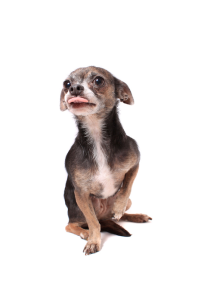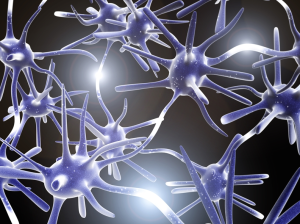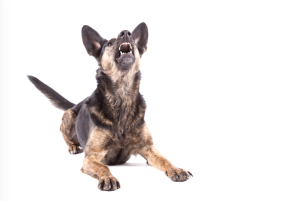 Modern dog training recognizes that many of our dog’s problematic behaviors are the expression of an underlying fear. When Fido is scared, he’s going to automatically flee, freeze or fight depending on whether he’s dealing with another dog, a person or with fireworks. His reaction will be determined by the situation, but also by his level of fear. A number of recent comments to some of my blogs, in particular to the post called “Reactivity and aggression in dogs -Managing and treating”, have made me realize how many of us still don’t truly grasp the importance of thresholds. My first point in treating reactivity, I explained, is to keep the dog under threshold, in other terms, at a distance at which the dog feels safe enough not to react to the stimulus that would typically trigger lunging and barking. Yet, many have raised questions and concerns about their ability to redirect the dog’s attention using treats, while the dog is reacting. If the dog is reacting, he’s over threshold. Once the dog is in full emotional display, you can only manage the situation the best you can. This is true for all types of fear. Effective treatment cannot happen at that level. Why? Because of what happens in the brain. To really understand how to help our pooches, we need to take a look at what goes on inside their heads. Since I’m not a neurologist and brain science is a very complex field of study, we’ll keep it simple, at a level that even I can grasp.
Modern dog training recognizes that many of our dog’s problematic behaviors are the expression of an underlying fear. When Fido is scared, he’s going to automatically flee, freeze or fight depending on whether he’s dealing with another dog, a person or with fireworks. His reaction will be determined by the situation, but also by his level of fear. A number of recent comments to some of my blogs, in particular to the post called “Reactivity and aggression in dogs -Managing and treating”, have made me realize how many of us still don’t truly grasp the importance of thresholds. My first point in treating reactivity, I explained, is to keep the dog under threshold, in other terms, at a distance at which the dog feels safe enough not to react to the stimulus that would typically trigger lunging and barking. Yet, many have raised questions and concerns about their ability to redirect the dog’s attention using treats, while the dog is reacting. If the dog is reacting, he’s over threshold. Once the dog is in full emotional display, you can only manage the situation the best you can. This is true for all types of fear. Effective treatment cannot happen at that level. Why? Because of what happens in the brain. To really understand how to help our pooches, we need to take a look at what goes on inside their heads. Since I’m not a neurologist and brain science is a very complex field of study, we’ll keep it simple, at a level that even I can grasp.
Have you heard of the expression “Neurons that fire together, wire together”? Another version of this saying is “Cells that fire together, wire together. Cells that fire out of sync, lose their link.” For a long time it was believed that after certain critical periods of development, the brain structure was fairly rigid. Advances in technology however, have shown that it’s not so. Neural pathways are constantly changing due to changes in the environment, to changes in our behavior and even to changes in our thoughts. This notion of neuroplasticity has gained in popularity over the past few years. Magnetic resonance imaging (MRI), for instance has allowed us to better understand how we can affect our mind, or more specifically our brain, on a physical level. For instance, if we scan our brain with an MRI, then meditate for 8 weeks and scan it again, we’ll find significant differences in the size of certain regions (Xiong & al., 2009; McGreevey, 2011).
 Donald Hebb (1949), father of the Hebbian theory was the first one to figure out that learning happens because when neurons repeatedly fire at the same time, they form connections with one another, they become associated. The more they fire together, the more those connections will become stronger, forming habits over a period of time. We can think of them like roads in our head. When we first learn a new skill, the information between the different parts of the brain that are associated with the action, travel on dirt roads with multiple detours. As we repeat the behavior over and over, the dirt roads gradually develop into paved roads. We think less about what we need to do and get better and faster at it. Finally, over time, the roads turn into highways and we can go much faster and without much thought. We’re now traveling on automatic pilot, or in other words, habits have formed. On the other hand, when a road is no longer traveled, it will gradually break down through a process of erosion and potentially disappear altogether. The old, “use it or loose it”. What Hebb had proposed a long time ago has recently been proven. By observing neural cells in real-time, in certain tadpoles that are transparent, the scientists were able to watch the connections change as the conditions changed (Munz & al., 2014). When cells fire out of sync, they lose their ability to make other cells fire. If you’re interested in a more detailed explanation of how neuroplasticity works, here’s a great blog on the subject: “Neuroplasticity in brief“.
Donald Hebb (1949), father of the Hebbian theory was the first one to figure out that learning happens because when neurons repeatedly fire at the same time, they form connections with one another, they become associated. The more they fire together, the more those connections will become stronger, forming habits over a period of time. We can think of them like roads in our head. When we first learn a new skill, the information between the different parts of the brain that are associated with the action, travel on dirt roads with multiple detours. As we repeat the behavior over and over, the dirt roads gradually develop into paved roads. We think less about what we need to do and get better and faster at it. Finally, over time, the roads turn into highways and we can go much faster and without much thought. We’re now traveling on automatic pilot, or in other words, habits have formed. On the other hand, when a road is no longer traveled, it will gradually break down through a process of erosion and potentially disappear altogether. The old, “use it or loose it”. What Hebb had proposed a long time ago has recently been proven. By observing neural cells in real-time, in certain tadpoles that are transparent, the scientists were able to watch the connections change as the conditions changed (Munz & al., 2014). When cells fire out of sync, they lose their ability to make other cells fire. If you’re interested in a more detailed explanation of how neuroplasticity works, here’s a great blog on the subject: “Neuroplasticity in brief“.
What does all this have to do with dogs? When we think about it, this process in the brain is what Pavlov, Konorski & Skinner’s have called conditioning. The dog already has neural connections between cells perceiving the food and cells responsible for the activation of salivation and digestion enzymes. When specialized cells fire at the sound of a bell right before others fire when the food is presented, these neurons develop connections between them over time. After a number of repetitions of this sequence, the cells firing at the perception of the bell trigger the cells responsible for salivation. Ta dah!
 So let’s bring all this back to fear responses. There are many things a dog can be scared of. Loud noises like fireworks or thunder can be terrifying to certain dogs. Fear of heights, of certain surfaces, of certain people, of cars, etc… All dogs are occasionally afraid. Fear keeps every being safe by generating quick automatic responses. Sometimes fear leads to panic, other times fear triggers reactivity, barking and lunging towards a perceived threat. In all cases though, if we could look into the dog’s brain, we would find direct connections between certain cells firing at the perception of specific types of stimuli and cells in the amygdala triggering the emotion and the reaction. From what we have learned of the brain, we now know that every time the sequence: stimulus – emotion – reaction occurs, the connections between the neurons just get stronger and stronger.
So let’s bring all this back to fear responses. There are many things a dog can be scared of. Loud noises like fireworks or thunder can be terrifying to certain dogs. Fear of heights, of certain surfaces, of certain people, of cars, etc… All dogs are occasionally afraid. Fear keeps every being safe by generating quick automatic responses. Sometimes fear leads to panic, other times fear triggers reactivity, barking and lunging towards a perceived threat. In all cases though, if we could look into the dog’s brain, we would find direct connections between certain cells firing at the perception of specific types of stimuli and cells in the amygdala triggering the emotion and the reaction. From what we have learned of the brain, we now know that every time the sequence: stimulus – emotion – reaction occurs, the connections between the neurons just get stronger and stronger.
This is where the notion of threshold is critical in any treatment protocol. From a neural perspective, a threshold is the minimal amount of stimulation needed to start a neural impulse. We’ll call an absolute threshold the point when something becomes noticeable to our senses. What’s the softest touch that we can feel, the softest sound that we can hear, the softest light that we can see, etc. In dog training, we refer to the threshold as being the point when a stimulus is at a minimal level to trigger a reaction.
- When the dog is under threshold, she may notice the stimulus but won’t show any sign of fear or any emotional reaction. She’ll be responsive to simple cues, will take treats, will easily turn away from the stimulus and is quite functional. At this level the dog feels safe.
- When the dog is at threshold, she’s right at the point when she doesn’t display fear or emotional reactions but she pays noticeable attention to the stimulus. She’s still responsive but will frequently look into the direction of the stimulus. At this level the dog still feels safe but is slightly on guard.
- When the dog is over threshold, she’s now showing signs of stress: from heavy panting, yawning or lick licking all the way to barking, lunging, attempting to run away or shutting down. Some dogs may stop taking treats while others will get a harder mouth, grabbing the treats frenetically. At this level the dog no longer feels safe.
 If we’re trying to help the dog, based on what we know about how things get wired in the brain, It’s essential to keep the dog under threshold or at most at threshold during the treatment. When using coercion-based methods, the common approach is to place the dog over threshold, then punish the dog for reacting. The assumption here is that with repetition, the dog will inhibit the reactions towards the stimulus. Unfortunately, this technique generally works only short term with a strong potential to backfire. The dog initially inhibits the reactivity but the connections in the brain between the stimulus and the emotional reactions have now strengthened and we’ve just added a new connection: presence of stimulus = punishment.
If we’re trying to help the dog, based on what we know about how things get wired in the brain, It’s essential to keep the dog under threshold or at most at threshold during the treatment. When using coercion-based methods, the common approach is to place the dog over threshold, then punish the dog for reacting. The assumption here is that with repetition, the dog will inhibit the reactions towards the stimulus. Unfortunately, this technique generally works only short term with a strong potential to backfire. The dog initially inhibits the reactivity but the connections in the brain between the stimulus and the emotional reactions have now strengthened and we’ve just added a new connection: presence of stimulus = punishment.
But even if we don’t do anything at all, as soon as the dog is placed over threshold, the connections between presence of the stimulus and emotional reaction gets reinforced by the simple process of repetition. So in order to minimize those cellular pathways, to change those highways into dirt roads and eventually back to raw land, we need to make sure we avoid pushing the dog over threshold.
The best approach is to keep the dog under threshold. When we expose the dog to the stimulus at a level where he still feels safe, and pair it with food or any other pleasant feeling, we can rewire those connections. Through repetitions, we can gradually establish new pathways between the stimulus and the emotional reactions. Fear is gradually replaced with feelings of calm and safety. Treats add to the sensation of pleasure and calm through the release of pleasure chemicals in the brain. Little by little we’ll be able to increase the level of intensity of the stimulus, until the dog can stay calm at all times.
Let’s take an example: Fluffy is terrified of fireworks. She runs under the living room table, shaking, every 4th of July. The connections between the loud explosions of the fireworks and her emotional reaction have developed over the years to the point where she’s starting to also salivate excessively. Anytime she hears fireworks, she’s being traumatized all over again. To help Fluffy, treatment would require Fluffy to be exposed to the sound of the fireworks at such a low volume that she can still feel safe. There are recordings of such sounds that can be easily purchased online. Engaging her brain in a stimulating and pleasant activity such as training might also help. It would take many repeated exposures to the stimulus (sound of the fireworks) while she feels safe and is given something pleasant, for new connections to start forming. Little by little, while always staying sub-threshold, we’ll be able to increase the volume until we finally get to a level similar to that of real fireworks.
In the case of reactivity towards other dogs or to people, you can read “Reactivity and aggression in dogs – Managing and treating” and for more information about fear, refer to “What happens to fear if left untreated?” And “Treated fear can return – even to the next generation”
Fear, anxiety and sometimes panic and phobia are quite common in dogs, as they are in people. Fortunately, in most cases, treatment protocols can help our canine companions overcome their fears and build their confidence level. In more difficult cases however, medication may be required to help the dog calm down enough to be able to implement the protocol. In any case, when we understand how our training impacts the dog’s neural connections we are better fit to make the right decision and truly affect changes that will help our dog.
Jennifer Cattet Ph.D.
Training several dogs at once
Review by pro trainer


Probably a good column to dispel the “don’t comfort your dog when it’s afraid” myth in, too…
This is an amazing article! Thank you so much! I’m going to feature it in my new blog post on today 12/17/2015. ThePetsCompanion.com/AdventuresinPetSitting